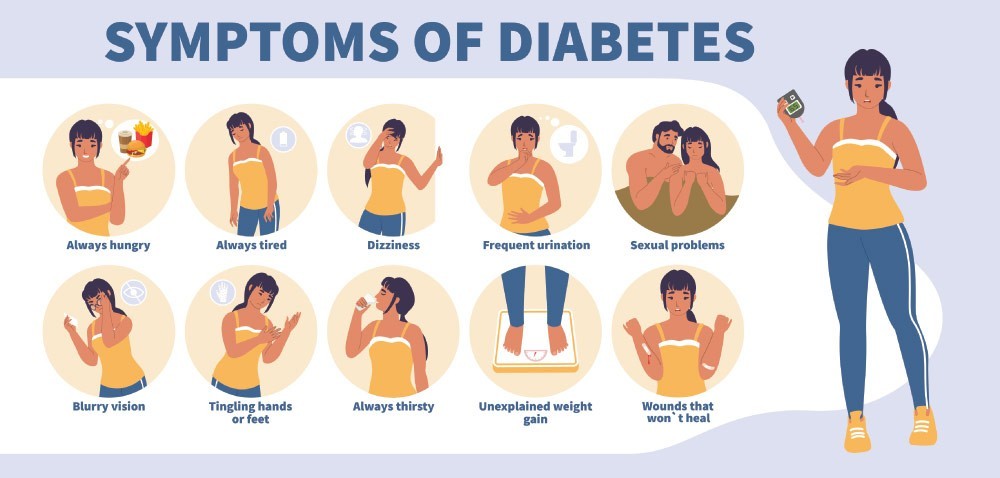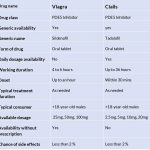
Contents
- 1 Diabetes Symptoms in Women
- 1.0.1 Early Signs and Symptoms of Diabetes in Women
- 1.0.2 Common Signs and Symptoms of Diabetes in Both Genders
- 1.0.3 How Does Diabetes Affect Pregnancy?
- 1.0.4 Signs and Symptoms of Gestational Diabetes
- 1.0.5 Complications of Diabetes during Pregnancy
- 1.0.6 Subscribe to MedicineNet’s Diabetes Newsletter
- 1.0.7 Can Diabetes Be Fatal?
- 1.0.8 From Diabetes Resources
Diabetes Symptoms in Women
Diabetes mellitus is a metabolic disorder that occurs when blood sugar (glucose) levels are too high (hyperglycemia). Glucose is the body’s energy source, and insulin is the hormone produced by the pancreas that converts glucose from food into energy. Insufficient insulin production or insulin resistance leads to type 1 and type 2 diabetes.
According to the CDC, 30 million Americans (9.4% of the population) have diabetes, with 7.2 million of them unaware of their condition.
There are two types of diabetes:
Type 1 diabetes is an autoimmune condition where the body’s immune system attacks the insulin-producing beta cells in the pancreas, resulting in insufficient insulin production.
Type 2 diabetes occurs when cells become insensitive to insulin, leading to inefficient utilization of blood sugar for energy.
Prediabetes is a condition preceding type 2 diabetes. It is characterized by higher-than-normal blood sugar levels that do not meet the diagnostic criteria for diabetes. This condition often goes unnoticed, with an estimated 84 million American adults having prediabetes, and approximately 90% of them being unaware. Without dietary and lifestyle changes, prediabetes can progress to type 2 diabetes within five years.
Early Signs and Symptoms of Diabetes in Women
While many symptoms of type 1 and type 2 diabetes are similar in both genders, there are certain symptoms and complications unique to women:
Vaginal itching and pain, as well as vaginal and oral yeast infections: An overgrowth of Candida albicans fungus can cause vaginal yeast infections and oral thrush. Symptoms of vaginal yeast infections include:
- Vaginal itching and pain
- Vaginal discharge
- Painful sexual intercourse
Symptoms of oral thrush include:
- White patches in the mouth
- Redness and soreness
- Trouble eating or swallowing
- Swollen red gums or inner cheeks
Decreased sex drive: Women with diabetes may experience a lower libido, blood flow problems to the genital area, nerve damage (diabetic neuropathy) resulting in vaginal dryness and decreased sensation, and decreased sexual response and orgasm.
Polycystic ovary syndrome (PCOS): This common cause of female infertility and insulin resistance can cause irregular periods, acne, thinning scalp hair, excess hair growth on the face and body, and an increased risk of developing diabetes. Approximately half of women with PCOS develop diabetes.
Urinary tract infections (UTIs): Women with diabetes are more susceptible to UTIs due to the presence of sugar in the urine, which provides an ideal environment for bacterial growth. UTIs occur when bacteria enters any part of the urinary tract.
Common Signs and Symptoms of Diabetes in Both Genders
There are symptoms that both men and women commonly experience with diabetes:
- Excessive thirst and hunger
- Frequent urination
- Weight loss or gain
- Fatigue
- Irritability
- Blurred vision
- Slow-healing wounds
- Nausea
- Skin infections
- Darkening of skin in body creases (acanthosis nigricans)
- Fruity, sweet, or acetone breath odor
- Tingling or numbness in the hands or feet
Both type 1 and type 2 diabetes share complications such as skin problems, eye issues, circulation problems, hypoglycemia, hyperglycemia, ketoacidosis, and the risk of amputation.
QUESTION
How Does Diabetes Affect Pregnancy?
Pregnancy can be unaffected by diabetes if blood sugar levels are properly controlled. Women with diabetes should discuss pregnancy plans with their doctor to achieve optimal blood sugar control before conceiving. It is crucial to understand how to monitor and control diabetes during pregnancy.
High blood sugar levels during pregnancy pose risks to both the mother and baby, leading to:
- Premature delivery
- Difficult delivery or cesarean section (C-section)
- Miscarriage
- Preeclampsia (high blood pressure with protein in urine)
- Birth defects
- Heavy birth weight in the baby
- Low blood sugar in the newborn
- Jaundice in the newborn (yellowing of skin and eyes)
- Respiratory problems in the newborn
- Exacerbation of diabetic eye and kidney problems in the mother
- Increased susceptibility to urinary or bladder infections
Signs and Symptoms of Gestational Diabetes
Doctors typically test for gestational diabetes between the 24th and 28th weeks of pregnancy. Although gestational diabetes often presents no symptoms, common signs include:
- Sugar in the urine (detected through urinalysis)
- Increased thirst
- Frequent urination
- Unusual fatigue
- Nausea
- Blurred vision
- Increased hunger
- Unintentional weight loss
- Increased susceptibility to infections (vaginal, bladder, and skin)
- Dry, itchy skin
- Increase in vaginal yeast and urinary tract infections (UTIs)
Complications of Diabetes during Pregnancy
Diabetes occurring during pregnancy is known as gestational diabetes. It typically develops between the 24th and 28th weeks of pregnancy, with blood sugar levels rising due to increased glucose requirements for the developing baby. If the body fails to produce enough insulin to meet this demand, gestational diabetes occurs.
Gestational diabetes usually resolves after childbirth, but women with this condition have an increased risk of developing type 2 diabetes. Risk factors for gestational diabetes include:
- Being overweight or obese
- Family history of diabetes
- Ethnicity: higher risk for Hispanics, African Americans, Native Americans, Alaskan Natives, Asian Americans, or Pacific Islanders
- Age over 25
- Previous gestational diabetes, stillbirth or miscarriage, or having a large baby (9 pounds or more)
- Polycystic ovary syndrome (PCOS) or another health condition associated with insulin issues
- Insulin resistance, glucose intolerance, or prediabetes
- High blood pressure
- High cholesterol
- Heart disease
Subscribe to MedicineNet’s Diabetes Newsletter
By clicking "Submit," I agree to the MedicineNet Terms and Conditions and Privacy Policy. I also understand that I may opt out of MedicineNet subscriptions at any time.
Can Diabetes Be Fatal?
While both men and women can develop diabetes, the disease presents unique challenges for women. A study conducted between 1971 and 2000 revealed that death rates for men with diabetes decreased during that period, but rates for women remained unaffected.
In general, women have a lower risk of heart disease and tend to live longer than men; however, diabetes significantly elevates the risk of heart disease in women, increasing the likelihood of heart failure. Another study found that heart attacks are more fatal in women with diabetes compared to men. Additionally, women with diabetes are more prone to the following:
Kidney disease: Both type 1 and type 2 diabetes can lead to kidney complications, which affect women more severely than men.
Depression: Women with diabetes are twice as likely to experience depression compared to men with diabetes.
Women with diabetes are at higher risk for poor blood sugar control, obesity, high blood pressure, high cholesterol, and various other complications compared to men with diabetes.
Several factors contribute to diabetes affecting women differently than men, such as decreased HDL ("good") cholesterol levels, reduced estrogen levels, less effective healthcare, PCOS, and associated difficulties in getting pregnant.


